Adopting a fruit-based diet offers incredible benefits and life-changing transformations if we learn how to do this in a species-appropriate way. However, to be successful in the long run, we must follow nature’s rules without letting dogmas or culture get in our way. This guide helps you to adopt a high-fruit diet in a healthy way – without the common mistakes that many had to learn the hard way.
There are different fruit-based diets, such as a frugivorous diet, fruitarian, high-fruit raw vegan, or fruit detox, which are similar but not the same. This guide is based on the biological diet of frugivores in nature, which includes different types of raw foods besides fruits, but many of the principles here can help you learn about other types of diets, too.
Feel free to ask or comment on anything fruit and diet-related below! We are happy to learn from your experiences. 🙂
Before you start… know what you are doing!
If you have come so far to consider and try a fruit-based diet, you are one of the lucky souls who know about our frugivorous nature! But… before you start, know what you are doing:
There are quite a few things to consider for a successful and sustainable frugivore diet. Please also read the basics of a fruit-based diet (before you start with this guide) to learn more about the natural fundament that the frugivore is based on, the benefits and risks, and critical questions about fruit-only fruitarian diets. This guide aims to help avoid common mistakes and minimize the risks associated with a fruit diet! However, despite all precautions, to avoid running into troubles in the long run, you do need to check for deficiencies regularly with your healthcare provider. We all have a past of toxic burdens and accumulated damages from a lifetime (and even generations) of living in unnatural habitats and eating sub-optimal foods. We all have some amount of genetic predispositions for different weaknesses. This can lead to deficiencies and/or detox symptoms that have to be taken seriously. While some people hardly have complications, others have a bumpy road!
Let’s dive into the the frugivore diet:
1. Know what a frugivorous diet is
The main reason a frugivore diet can fail is the lack of information on – and misunderstanding about – what a frugivore diet actually is. The frugivorous diet is the human species-appropriate diet. In nature, it is highly instinctual what animals identify and choose as suitable foods for them, using chemoreception and visual appearance: appealing look, pleasant smell, taste, and texture are all important cues in foraging and diet.
What would you eat in nature?
Chimpanzees, our closest relatives, are highly attracted to ripe fruits. And, I argue, that most humans would choose fruits over other foods in the wild, too (raw and unseasoned). However, because, we humans are not living in our natural habitat and have far deviated from our natural foraging behavior, there is much that we have to learn by observing the diet of closely related species diet in the wild.
Frugivore diet in nature
For the reasons mentioned above, one key to rediscovering the human species-appropriate diet is studying what the frugivorous chimpanzee diet looks like in the wild. Understanding the chimpanzee diet helps us evaluate what foods deliver complete nutrition in our original ecological setting. After all, the nutritional requirements of chimpanzees and humans are highly likely interchangeable:

Note: Nutritional requirements are known to be highly similar in humans and chimpanzees! The nutrient requirements are nearly identical, which is why the RDAs for humans are used for dietary guidelines for chimpanzees in captivity. Vice versa, studying the natural chimpanzee diet can be just as useful to understand the human natural diet.
So, what do chimpanzees eat?
Chimpanzees are frugivorous omnivores and preferably forage (tropical) fruits, as well as nuts, greens, tubers, insects, and occasionally meat (although not all individuals eat meat, which seems to be more of a male social behavior rather than a nutritional requirement).
They also have extended periods of eating fruit only. Depending on seasonal availability, they can go weeks eating the same fruit. Figs are one of their staple fruits. It’s not known entirely what foods in the wild are fallback foods in times of limited access to preferred foods.
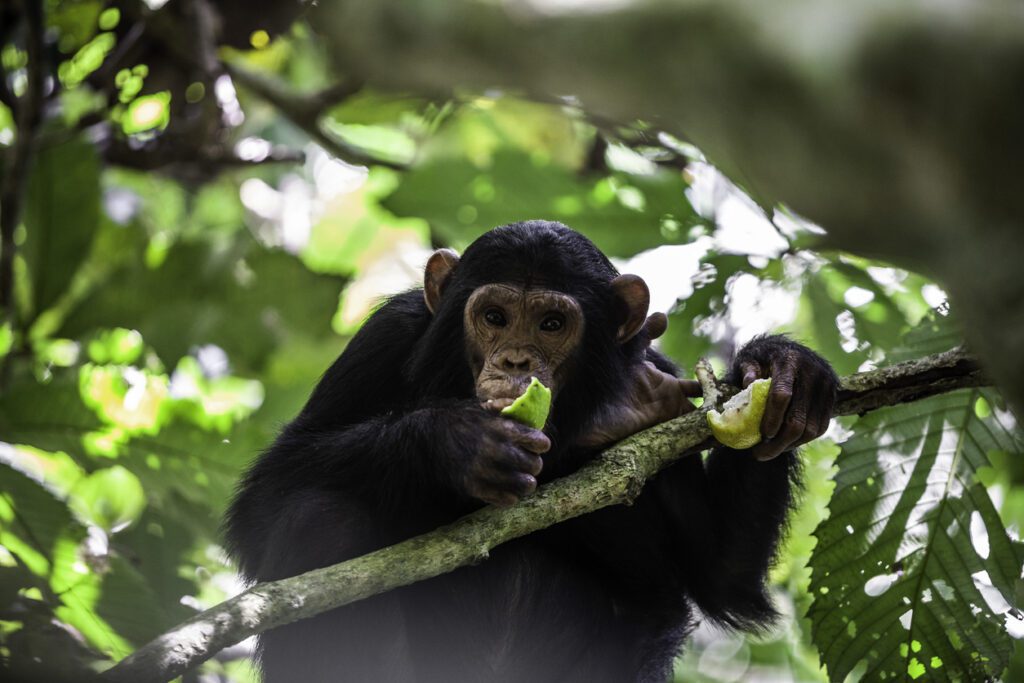
Overview of the chimpanzee diet in the wild
This is an average chimpanzee diet, but in nature, there is great variability. Not all chimps eat meat. Read more here.
70% tropical fruits and figs
24% other plant-based foods (young leaves, flowers, nuts, seeds, barks, tubers)
6% animal-based (eggs, insects, and meat of small vertebrates) of which 4% are insects and 1-2% is meat
Humans are tropical frugivores, too
Like apes and many other primates, humans have distinct adaptations to high-fruit diets. Examples are the complex hand, loss of Vitamin C production, specialized color-vision, and instinctual attraction to fruits. Thus, we have much to learn from the chimpanzee diet in the wild – as suggested by K. Milton (1999):
“Anthropoids, including all great apes, take most of their diet from plants, and there is general consensus that humans come from a strongly herbivorous ancestry. Though gut proportions differ, overall gut anatomy and the pattern of digestive kinetics of extant apes and humans are very similar… Though human gut proportions and some characteristics of the human diet may have altered over time, humans should still require the same basic nutrients as apes.”
K. Milton
A high-fruit diet is the human evolutionary diet
Like any other diet, a frugivorous diet is not perfect, but it is the optimal and most suitable diet for the human body. This is because nature optimizes for reproduction, not for health! But yes, undoubtedly, our fruit-based species-appropriate diet brings us as close to perfect health as possible! This fundamental concept of his evolutionary dietary concept is to eat the foods (the chemistry), that the body is adapted and equipped to metabolize.
2. Make tropical fruits your main foods
Tropical fruits should be the main food on a frugivore diet. I am placing this point at the top of this list because it is probably the most serious and common mistake: The fundamental mistake when being on a fruit diet is to rely mainly on temperate and sub-tropic fruits. Those types of fruits are usually more watery and acidic and have not evolved with primates! It is essential to get enough high-quality, ripe tropical fruits.
Ripe tropical fruits are the foundation of successful frugivorous nutrition – the natural human diet.
Tropical fruits have another nutritional profile than temperate fruits from colder climates. They are generally more nutritious and contain more energy (calories) from carbs (sweet taste), lipids, and proteins and higher levels of micronutrients (for example, iron or omega-3s). As frugivores primates and apes coevolve with fruits. Therefore, not eating enough ripe tropical fruits on a fruit diet carries the risk of undernourishment. Here is a list of some of the most popular tropical fruits (click on them to learn more about the nutritional and medicinal benefits of each of those superfruits):
- Açai
- Acerola
- Avocado
- Bananas
- Breadfruit
- Mangosteen
- Custard Apple
- Guava
- Durian
- Tropical Figs
- Rambutan
- Lychee
- Dragonfruit
- Papaya
- Mango
- Passionfruit
- Granadilla
- Soursop
- Starfruit
Why are tropical fruits so important? Our species originated in tropical forests, which is why our ancestors were tropical frugivores – and why our bodies still require the nutrition of tropical fruits:
Tropical forest clearly represent a key human habitat that can no longer be ignored in the context of deep human history.
Scerri et al., 2022
Temperate fruits cannot sustain us in the long term! Apples, strawberries, melons, kiwis, and other acidic fruits cannot sustain us entirely. In the short run, yes, those types of fruits are great for cleansing periods and fasting or juicing.
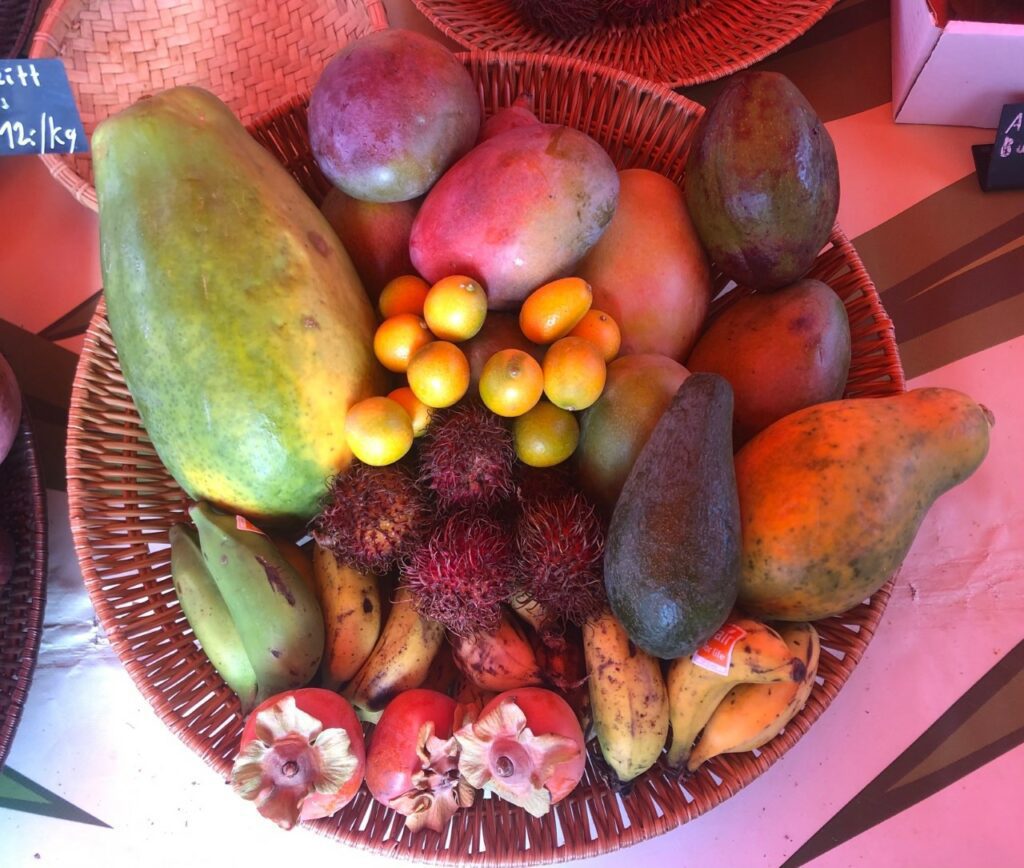
Know when you need fallback foods: Frozen and dried tropical fruits, bananas, coconut, raw nuts, and greens can be a staple if you do not live in the tropics. For example, frozen açai with bananas in a smoothie bowl can make a good meal. However, if we don’t live in our tropical natural habitat, getting the food we need is nearly impossible! A frugivore’s diet demands that we live in a tropical, natural environment in the long run! Therefore, if you cannot access enough high-quality tropical fruit and nuts, we unfortunately are forced to get other nutrition sources – fallback food or survival food (read more in section 8).
Needing fallback foods is also what “happens” to apes (and other animals) in the wild. The most extreme case of fallback food is the food our ancestors, who moved out of the tropics: cooked foods like root vegetables, cooked meat, but also dairy and grains later on. Those can be called survival foods.
There are levels to fallback foods, and it is actually the birth of the idea of a “balanced diet.” A balanced diet is an attempt to combine survival food in the best way with the goal of imitating the nutritional profile of our natural, frugivorous diet. Having to eat fallback foods does not mean we need to eat animal foods! However, we need to understand our nutritional needs as a dislocated species and how we can best get the nutrition we need in the area we live in. Our ancestors that migrated out of the tropics had very limited ways to access food. So their survival foods were mostly animal-based. Today, we fortunately have more options. If you do not live in the tropics, you might buy air-imported fruits, frozen fruits, or find an online supplier of tropical fruits – and get as many as you can. We just try to do the best we can!
Some online suppliers of tropical fruits are Tropical Fruit Box (U.S.), Jurassic Fruit (E.U.) Fairkoestlich (Switzerland). Also check out your local Asian or African stores for fresh produce. Please leave suppliers or your ideas on how to get good exotic fruits in the comments. Those are not affiliate links 🙂
This guide is dogma-free, so cooked foods are seen as what they are here: fallback and survival foods when living outside the human natural tropical habitat. If you do not live in the tropics, you likely need to eat some cooked foods in the long run, so that you can meet your nutritional need. This does not mean that you can go for extended periods on raw foods or fruit only, tough. Just try to get as many fruits into your diet as possible!
Read more about the importance of tropical fruits here and the evolutionary background of temperate fruits and humans here, and why humans are a tropical species here.
3. Eating tender greens, sprouts, nuts, tubers, and seeds
Besides fruits, a frugivore diet includes many other types of foods. Frugivorous primates eat fruits, greens, nuts, tubers, insects, and sometimes meat (see section 1). Those foods provide the necessary nutrition for the human body and are sometimes referred to as “building” foods or “fall-back” foods.
Tender leaves and greens play a huge nutritional role in the chimpanzee diet, providing protein and minerals, which is why we should not leave out huge salads! Read more in-depth “how to do greens right” here.
If you do not live in the tropics in a food forest, it most likely is necessary to supplement your diet (see below) and even add “survival” foods! Read also about the risks of a fruitarian fruit-only diet here.
Foods to integrate on a fruit diet as part of a natural frugivorous diet are:
- Ripe, tropical fruits
- Greens (tender leafy greens, microgreens, sprouts)
- Raw nuts and seeds (especially tropical ones) like coconuts, Brazil nuts, pecan, macadamia, and chia
- Root vegetables like carrots, celery and beetroot, and starchy sweet potatoes. Steaming and baking is a good option here.
- Anything appealing and safe to be eaten raw. Animal products might be an option, depending on your circumstances and location.
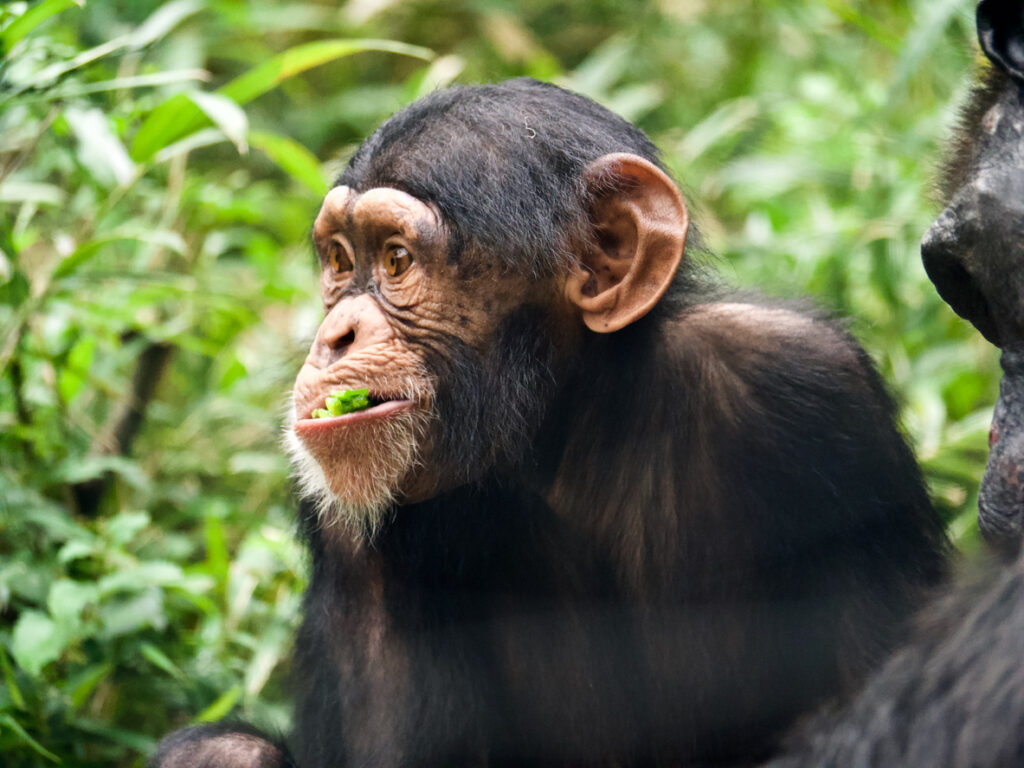
Striving for the human natural diet while not living in our tropical natural habitat remains a challenge even in times of effective fruits and food transportation around the world. Therefore, we cannot be perfectionists, just do the best we can. If you feel like doing a period of clean eating and trying to address health problems, you can do a fruit-only diet for a limited amount of time (weeks or months). In the long run, you need to integrate more other foods to nourish your body. It always depends on your individual situation, health, and your goal.
“Survival” fallback foods
If you feel like the above foods are not sufficient for you – because you can’t obtain enough of them during winter or other struggles – consider integrating some of the fallback foods that our ancestors have eaten to survive in cold habitats.
Find an overview of biologically suitable foods and survival foods for humans here.
4. Eat your fruits ripe
“Eat your fruits ripely!” might sound too basic for a piece of serious advice, but there is a need to emphasize this! Only ripe fruits provide the full nutrition and energy we need form our diet! During the ripening process, nutritional chemistry changes (read more on that here). This has a biological reason: the plants only attract fruit-eating seed-dispersers when their seed (embryo) has matured and is ready to grow into a new plant.
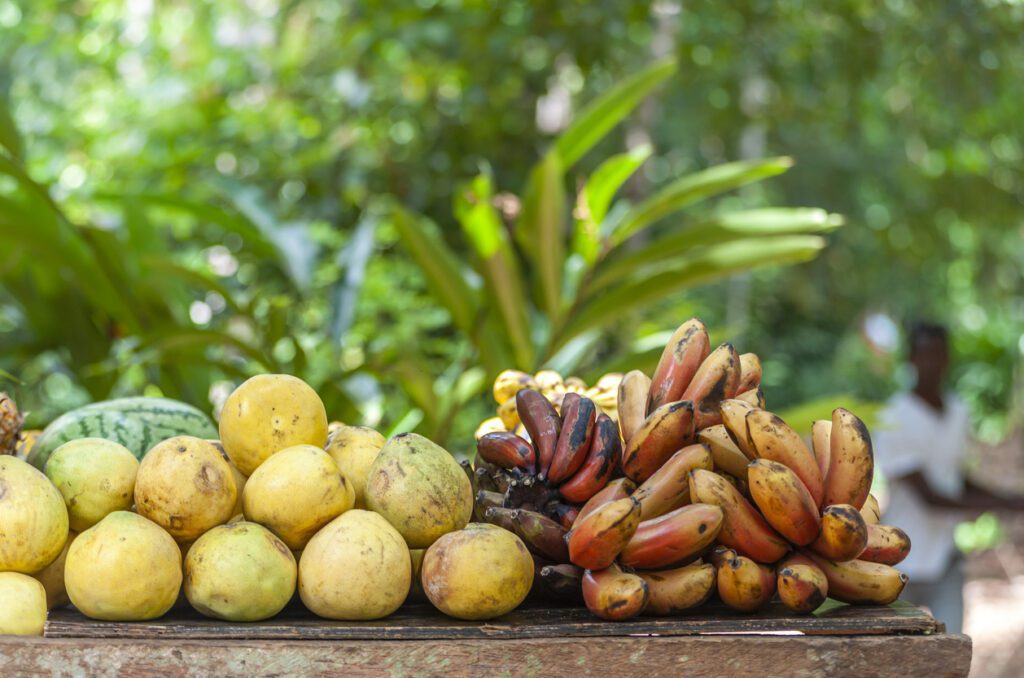
Understanding the effects of fruit ripeness – not only on sweetness, color, taste, and smell – but also on nutrition is especially important on a fruit diet. Most of us only have limited access to high-quality ripe tropical fruits.
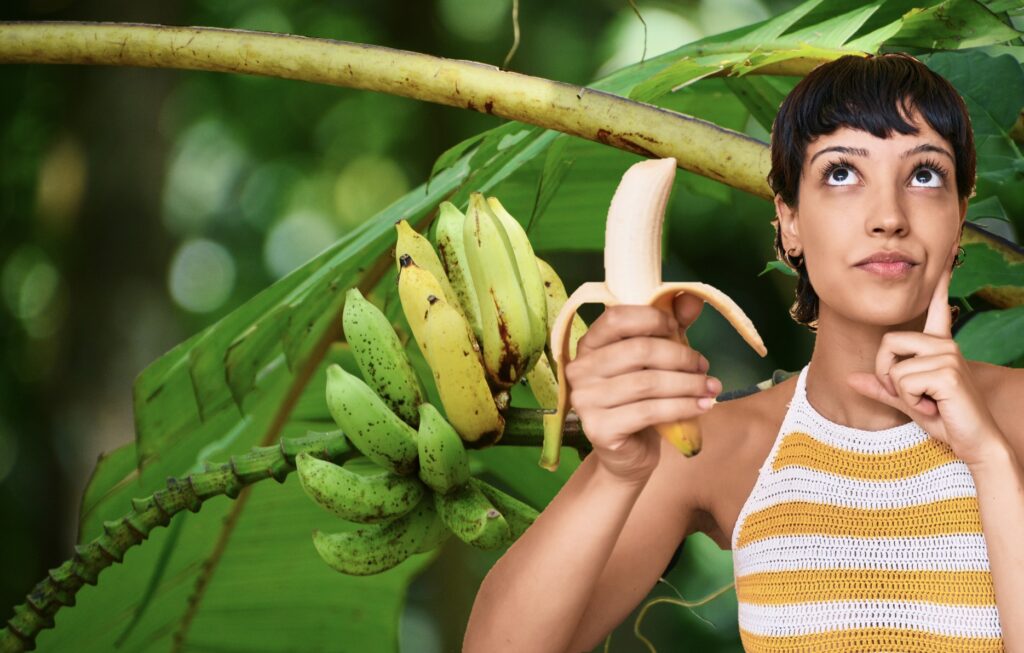
Fortunately, some of our favorite tropical fruits ripen after being picked from the trees, like mangoes, bananas, and papaya (see a list here). In addition, as a second-best option, buying frozen fruits is excellent for getting ripe fruits because it is fruits that are too ripe to be transported that are being frozen to be sold.
5. Eat enough calories
Avoid undernourishment on fruit-based and raw food diets! Raw foods have a much higher water content than calorie-dense cooked and animal foods. We have to learn that the volume of food we need is bigger on a raw food diet. By choosing sweet tropical fruits, like bananas, jackfruit, durian, papayas, and mangoes, we can achieve our nutritional needs faster than by eating watery, acidic fruits. To obtain around 2500 calories, you would need to eat nearly 3 kg of tropical fruit. However, if you include calorie-dense nuts or fatty fruit, the volume is less.
This is an example of a day of frugivorous meals of ca 2000- 2500 calories a day:
- One açai bowl with 200 grams açai berries and 3 bananas, plus added greens and chia seeds (650-700 calories)
- One handful of Brazil nuts (150-200 calories)
- One banana and one mango as a snack (200-250 calories)
- A fruit meal with a variety of fruits (300-400 calories)
- One handful of pecan nuts (150-200 calories)
- One large green salad with avocado and mangoes (300-400 calories)
- Banana Smoothie with coconut milk (250-350 calories)
If we compare this to chimpanzees, we see that on a raw, plant-based diet, eating large amounts of food is observed in nature: Chimpanzees eat around 3-6 kilos of food in the wild – depending on the food type and body weight (a wide range between 25 – 70 kg)! It might come as a surprise that chimpanzees care more about the sugar content of their foods than the protein content (Takemoto, 2002) – however, these findings will make more sense when you read about proteins in a fruit-based diet below…
Mind yourself that eating a (mostly) raw diet with lots of ripe fruit will help you reach your optimal weight. Natural sugar will not make you gain weight if you are overweight. If you are underweight, the species-appropriate diet can help improve your gut health, which in turn will optimize nutrient absorption.
Also, check out our recipe section for fruitarian, frugivore, and fallback meal inspiration.
Protein on a fruit diet
Where do we get proteins from on a fruit diet? All raw foods, including fruits, contain some amount of proteins. Tropical fruits contain around 1-3.5 grams of protein per 100-gram fruit. Many larger mammals in the wild are plant-eaters. And chimpanzees in the wild get their proteins mostly from tropical fruits, greens and nuts. If you get enough proteins on a fruit diet largely depends on the quality of fruits, but also on additional foods on greens and nuts. A 2000-2500 calorie day of typical frugivore foods provides around 50-55 grams of proteins, which meets the Recommended Daily Allowance (RDA) of around 0.8 grams/kg body weight per day. Be aware that wild tropical fruits contain more protein than cultivated ones.
But how can the relatively low amount of protein in a high-fruit diet be enough when the standard diet contains much more? We must understand that proteins are not “burnt” like energetic nutrients (sugar and fat). Instead, proteins are broken down into amino acids and are recycled if needed, while excessive amino acids are transformed into urea and are excreted via urine (see here the protein metabolism overview). A high protein intake is, therefore, well known to overburden or even damage the kidneys. We are not adapted or physiologically well-equipped to metabolize a high-protein diet (read more here). A standard diet might contain too much… not the other way around.
Because of the recycling of amino acids, the body is only forced to use protein as an energy source when we do not provide the body with enough fuel to burn (sugar, fat). Yes, we still need to take in the amino acids from raw foods, but we do not need nearly as much as most people believe we need. Listen to one of the leading nutrition scientists of the world, Stanford Professor Christopher Gardener, confirming this:
(One thing I miss in this video, in terms of protein intake, is the information that excess protein is stressful to the kidneys, though! And I disagree about beans and grains being suitable foods for humans. On a frugivore diet, the main protein sources are greens and nuts.)
Thus eating enough calories, and sweet fruits is what helps keep the muscle mass and protein levels. Chimpanzees create some serious muscles on a high-fruit diet!
Read also our in-depth article and calculations on protein on fruit diets!
6. Taking the right nutritional supplements
As a consequence of living in a sub-optimal environment (and a degraded, polluted one), we can only get as close to a natural human diet as possible while acknowledging the shortcomings and accounting for them. The need to take supplements depends on the area you live in, the quality of food you can access, and, how healthy (or pre-damaged by toxins and diet) you are. After all, the food sources that frugivores get in the wild, generally contain more nutrients (see below).
Supplements to consider on a raw, fruit-based diet generally
- Vitamin B12
- Iodine
- Selenium
- Calcium
- Magnesium
- Green powders and leave extracts
Vitamin B12 and K2 are intrinsically produced by our microbiome (bacteria in the gut) – however, most of our microbiomes are severely pre-damaged by antibiotics and pesticide exposure. Supplementing those two vitamins should be considered, as we can easily slide into a deficiency as long as our microbiome is not perfectly healthy (read our full article on B12 on a plant-based diet here).
Iodine should be supplemented if you live off the coastline without iodine-rich air and foods. Consider supplementing with kelp or sea moss! Sea moss is an important functional food on a raw diet to increase mineral intake!
Selenium is a synergist of iodine and needs to be added to the diet when you live in an area with selenium-poor soil (Europe). Luckily, a few Brazil nuts provide selenium as a functional food.
Magnesium and calcium are minerals that are usually abundant in food. We only need additional calcium during intense detox. Some take it long-term, as it is unsure whether the plant foods we eat today contain the same amount as food grown in the wild. Also, calcium uptake and metabolization are dependent on the “sunshine nutrients”:
Additional supplements to consider if you do not live in the tropics or sub-tropics
- Vitamin D3
- Vitamin K2
- Magnesium
- MSM (organic sulfur)
Why? Because as a member of a tropical species, you need to “supplement the sun” if you live in an area with low sunlight. Vitamin D deficiency was such a huge factor in human health that the lack of the sun was a selective force that drove the evolution of lighter skin color (which produces vitamin D in places poor in sunshine). The ancestors of cold-native people knew the need to take cod liver oil.
Vitamin D3, vitamin K2, calcium, and magnesium work synergistically, which is why it is helpful to supplement those nutrients together. Besides an oral Vitamin D3 supplement, you can use a high-quality UV light therapy (sun-studio or UV-light device).
If you cannot get sulfur-rich fruits like durian in your diet regularly, consider taking organic sulfur (methylsulfonylmethan or short MSM) to supplement this mineral (read more on the benefit and necessity of taking MSM here)
Additional supplements during intense detox
Changing your life to healthier habits will enable your body to eliminate more toxins and can induce detoxification symptoms when the liver or kidney is over-tasked. To support the liver in its biochemical activities (especially phase II detoxification) to transform and prepare them for elimination, you can take the co-factors and other nutrients that are needed and used in the process:
- Zinc
- MSM
Herbal supplements: medicine and nutrition
Herbalism is an ancient art, but it is also found in nature. Chimpanzees were found to self-medicate with herbs in the wild. Thus, intuitive knowledge is essential in nature – and for us to find the way back and return to our natural diet.

Herbal supplements can be used for their medicinal properties or functional (nutritional) properties. Plants, especially herbs, contain secondary metabolites – bioactive phytomedical molecules. This is the concept of the original natural medicine. Some plant supplements can be used for their high nutrient content, i.e., to increase nutrients that are hard to find in our diet. Those are functional foods: For example, selenium in Brazil nuts, iodine in kelp, and minerals in leaves, i.e., zinc from guava leaf, to name a few.
Getting nutrients in their natural, organic matrix is the better option most of the time. For example, iodine can have a toxic effect if selenium is not present abundantly. However, iodine in kelp comes bound in different chemical forms, which do not act the same as the isolated iodine.
If you do consider supplementation, it is essential to choose natural, additive-free, and high-quality products! You can find more details on supplementation in this article here:
7. Not all fruits are equally suitable for us!
Not all fruits are optimal for our health. Why? We are fruit-eaters (frugivores), but not all fruits are originally human foods. The reason is that we have co-evolved as seed-dispersers with some fruits but not with all fruits.
Tropical fruits
Because humans originated in tropical Africa, our original and optimal fruits are sweet tropical fruits like banana, durian, mango, papaya, lychee, etc. Primates are important seed dispersers of tropical fruits and, thus, share a symbiotic coevolutionary history. Not only do they nutritionally match our needs, but they also have none to low toxic defense compounds against humans (even the seeds!). Therefore, it is no surprise that most tropical fruits are edible for humans. Tropical fruits generally contain more proteins, fats, and other nutrients than temperate fruits. Therefore, the bulk of fruits on a frugivore diet need to be tropical fruits (see above).
Temperate acidic and non-sweet fruits
The situation is a bit different for fruits that grow in temperate climates. Many acidic and temperate fruits we eat today are actually not edible for humans in their wild form – but suitable for birds. This is because many temperate fruits we eat today have evolved as a food source for seed-dispersing birds. Many cultivated temperate fruits were bred extensively to render them palatable by enhancing sugar content and decreasing sour or toxic components.
Read more on tropical vs. temperate fruits here.
Read more about non-sweet vegetable fruits here.
Some of the fruits that might not optimally suitable for humans are nightshades, squashes, citruses and avocado:
How suitable is a specific fruit for humans?
In some cases, the taste of a fruit reveals that it is not a fruit we wouldn’t consume in large amounts in nature, like acidic citrus or avocado without seasoning. Some of those fruits can even cause reactions like allergies, heartburn, and stomach issues in sensitive people. Nightshades were bred to taste better and drastically reduce the toxin content. Still, they cannot be considered optimal, as many people do show inflammatory reactions to consuming them.
We have to take into account that taste is a highly individual perception, and we all have different preferences. Many fruit-eaters love indulging in whole avocado fruit, while others do not like the taste of avocados at all.
However, unequivocally, fruits that originally were toxic in their wild form are not really suitable for humans – so knowing the cultivation history and the wild form of a fruit matters in terms of health.
Undoubtedly, we can consume and enjoy those fruits if we like them – especially in temperate areas. But, we are well-advised for a successful fruit diet, to pay attention to that topic and not base the entire diet on temperate and acidic fruits long-term.
Read more about different fruit types and categories here
8. Know the quality of your fruits and foods
The quality of fruits might be the most challenging task. Your fruits must be ripe, nutrient-dense, and free of contaminants! Keep in mind that conventional farming not only leaves toxic residues on the harvest but destroys soil microorganisms and reduces minerals in the soil and plants. Every alienation from a natural ecosystem that the human body has not adapted to is a step away from living and eating species-appropriate.
Quality of food and fruits from best to worst:
- Wild fruits
- Fruits from permaculture and food forests
- Fruits from small farmers you know and trust
- Demeter or bio-dynamic label
- Your own garden
- Organic fruits
- Conventional from small farmer
- Conventional from large-scale production (avoid)
Unfortunately, organic foods are notorious for being expensive. And some types of fruits are simply unavailable in organic quality where we live. Just try as much as you can. And if it is not possible, buy fruits with a thick shell or peel (which luckily are often tropical ones).
Wild fruits: We often don’t have access to the fruits (and nutrients) of our original natural habitat
An important factor when it comes to a fruit-based diet is the circumstance that we do not live in our natural habitat and only have very limited access to wild, ripe tropical fruits (unlike wild chimpanzees). This is essential for the success of the diet, because wild fruits, do have a different nutritional profile: they contain more proteins, another carb composition, and more micronutrients (K. Milton, 1999).
“Humans clearly come from an evolutionary past in which hexose (fructose) – rather than sucrose-dominated fruits were consumed, and human digestive physiology should, therefore, be best adapted to a carbohydrate substrate similar to that of wild fruits. But, in addition, wild fruits differ in other respects from their cultivated counterparts. These include a high content of roughage – woody seeds, fibrous strands – as well as higher average protein levels, higher levels of many micronutrients … and , at times, considerable pectin.”
Kathrine Milton; 1999
The same applies to other types of foods, like greens and nuts:
“Many fruits and unconventional foods are available in the tropics and represent valuable minerals sources. Green leaves appear as outstanding mineral sources, especially in calcium and iron, followed by nuts.”
Leterme et al., 2006
This insight is another challenge for our natural human diet in modern society and must be accounted for nutritionally when adopting a frugivore diet.
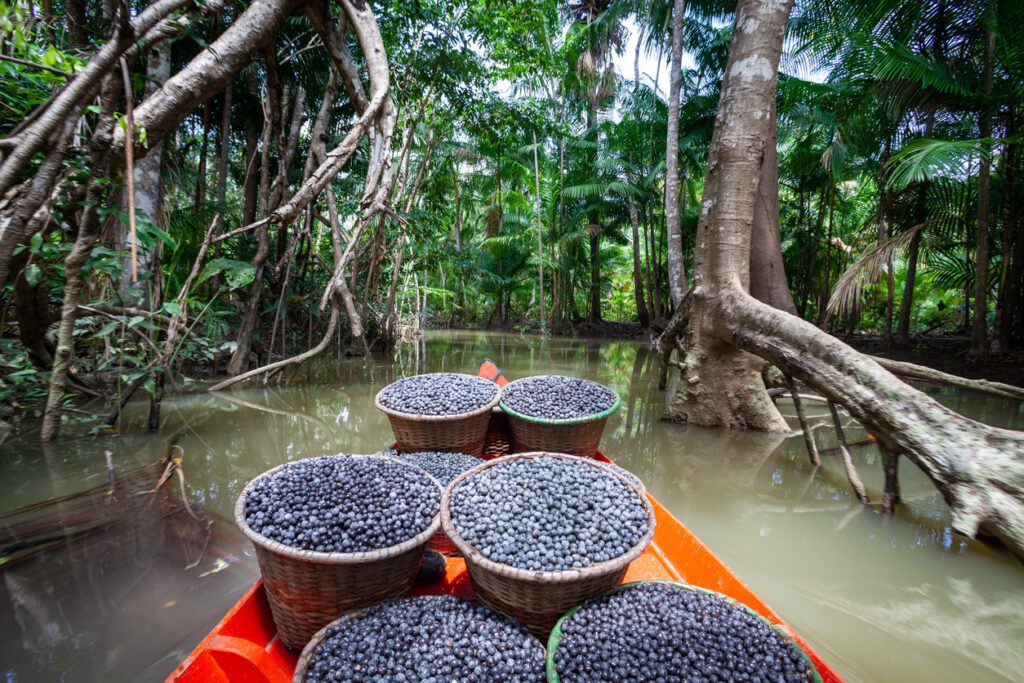
9. Relearn to trust your natural, instinctive knowledge
How do we actually know what the human biological diet in the wild would be? In nature, we observe animals consuming foods, and based on this information, we describe the diet of an animal species. With humans, however, we seem to be confused! Why?
Animals in the wild intuitively know what their diet is. However, humans can’t really do that because we do not live in our natural habitat. Therefore, we can only study what we should do by studying our primate relatives in the wild… And we can relearn what we would eat in nature:
Visual cues and chemoreceptors (taste buds, olfactory perception) have evolved in each animal species to know what is food and what is not. Bitter, disgusting, tasteless, etc., are warning and preventing us from eating something potentially harmful.
A raw diet will help you learn again to discern what is edible and tasty in its natural state. Anything that needs flavoring or cooking to be tasty is not human food. Over time, instincts tell us reliably what to eat and what not.
10. Do not jump in too fast
Transitioning to a healthy diet takes time. Just jumping in from 0 to 100% without an adequate adjusting period can stress and overburden our body’s detoxification and elimination system. Our species-appropriate diet is the goal, but often, this cannot be achieved within a few weeks. Jumping all in can cause severe discomfort and detox symptoms in many people. Many people report that it took years to transition fully, and some keep going forth and back, doing their best, one step at a time.
Some take longer than others
As a rule of thumb, the older you are and the more toxins have accumulated in your body, the longer it takes to transition. Transition slowly and take your time. For example, you might start by leaving meat and dairy behind and then leaving grains and beans behind, and simultaneously always keep increasing the amount of raw foods, especially ripe fruits.
Stages of transitioning into a fruit diet
There is no “rule” on how to transition. Just take steps to eliminate more and more foods that are not suitable for humans and increase raw, high-quality foods. A good start is to buy processed foods, meat, dairy, grains, and buying organic foods. Sometimes, such a change alone can already induce a detox crisis. When detox crises hit, simply take it slower. A next step could be to gradually decrease the number of cooked foods and increase raw foods, then raw vegan and increasing fruits.
Possible stages of eliminating foods that are not part of a species-appropriate diet:
- Eliminate meat
- Eliminate dairy & eggs
- Eliminate grains and legumes
- Slowly decrease cooked foods
- Striving towards eating more fruits and frugivore foods
- Getting as much frugivore foods as you possibly can and evaluate if you need some of the (cooked) fallback food if you cannot access high-quality tropical fruits and nuts necessary to obtain the nutrition you need
- You can do limited periods of time on fruits only to enhance detox if needed
11. Know what detox symptoms are
It is also crucial to know that this is not always smooth. When a detox crisis occurs, it is important to recognize it as a healing crisis and distinguish the symptoms from a degenerative state. While the old hands (or old monkeys) and experts know this, it’s a frequent mistake that actually drives people to cease and give up. Those healing crises are very often misinterpreted as a sign of a bad diet or deficiencies.
To understand why transitioning too fast can cause detox crises, understand what detoxification and its symptoms look like. Detox symptoms can be very individual, as it can be the temporary worsening of your main symptoms or the emergence of prior symptoms. There are also more general symptoms like feeling tired, dizzy, or flu-like symptoms. Those are often caused by the mobilization and elimination of stored molecules that the organism plans to expel but does not have the resources to do so. It can be described as “lymphatic congestion” because the lymph system and kidneys and intestines are the primary routes of elimination (read more here). By transitioning too fast, you can mobilize the “safely” stored toxins more quickly than they can be eliminated.
Healing crises occur again and again and in different intensities with varying symptoms. The main difference between a degenerative process and a detox crisis is that the symptoms are temporary. And we should simultaneously see improvements in other previously “troubled areas.”
While detox symptoms are common and temporary, they can still be damaging when detoxing too intensely. Take a step back, incorporate some more of your old foods, and go two steps in front later. Change the diet at your own pace. It’s not a failure if you cannot eat entirely “clean” for a while.
12. Mind your teeth health
Many forget that on a high-fruit diet, teeth are often and prolonged exposed to sugar and fruit acids. We can go for months and even years feeling awesome… but then teeth sensitives kick in. Enamel damage is sometimes reported, but due to critical mistakes. But not everyone on a fruit diet gets dental issues because a fruit diet per se is not the problem! There are, however, things we need to pay attention to prevent enamel damage. Enamel mineralization is a whole subject on its own. Thus, we have an in-depth article and guide.
References
- Adult male chimps regularly eat meat, unlike other chimps (available at https://www.pnas.org/post/journal-club/adult-male-chimps-regularly-eat-meat-unlike-other-chimps).
- K. Kalantar-Zadeh, H. M. Kramer, D. Fouque, High-protein diet is bad for Kidney Health: Unleashing the Taboo. Nephrology Dialysis Transplantation (2019), doi:10.1093/ndt/gfz216.
- LSUHSC School of Medicine – Biochemistry and Molecular Biology. LSU Health New Orleans (available at https://www.medschool.lsuhsc.edu/biochemistry/Courses/Biochemistry201/Desai/Amino%20Acid%20Metabolism%20I%2010-14-08.pdf).
- J. Shurkin, Animals that self-medicate. Proceedings of the National Academy of Sciences. 111, 17339–17341 (2014), doi:10.1073/pnas.1419966111.
- K. Milton, Nutritional characteristics of wild primate foods: Do the diets of our closest living relatives have lessons for us? Nutrition. 15, 488–498 (1999), doi:10.1016/s0899-9007(99)00078-7.
- Scerri, E.M. et al. (2022) ‘Tropical forests in the deep human past’, Philosophical Transactions of the Royal Society B: Biological Sciences, 377(1849). doi:10.1098/rstb.2020.0500.
- No author (2020) Buy a chimp a meal, Chimfunshi Wildlife Orphanage. Available at: https://chimfunshiwildlife.org/appeal/buy-a-chimp-a-meal/ (Accessed: April 26, 2023).
- H. Takemoto (2002) Phytochemical determination for leaf food choice by wild chimpanzees in Guinea, Bossou. Available at: https://www.greencorridor.info/data/Phytochemical_Determination_for_Leaf_Food_Choice_by_Wild_Chimpanzees_in_Guinea__Bossou.pdf (Accessed: July 23, 2023).
- Staff, H.H.P. (2022) How much protein do you need everyday? Harvard Health. Available at: https://www.health.harvard.edu/blog/how-much-protein-do-you-need-every-day-201506188096 (Accessed: April 26, 2023).
- Raw Figs – Your Health Search Engine (available at https://www.rawfigs.com/?s=lymphatic%2Bsystem®=0).
- Leterme, P. et al. (2006) “Mineral content of tropical fruits and unconventional foods of the Andes and the Rain Forest of Colombia,” Food Chemistry, 95(4), pp. 644–652. Available at: https://doi.org/10.1016/j.foodchem.2005.02.003.


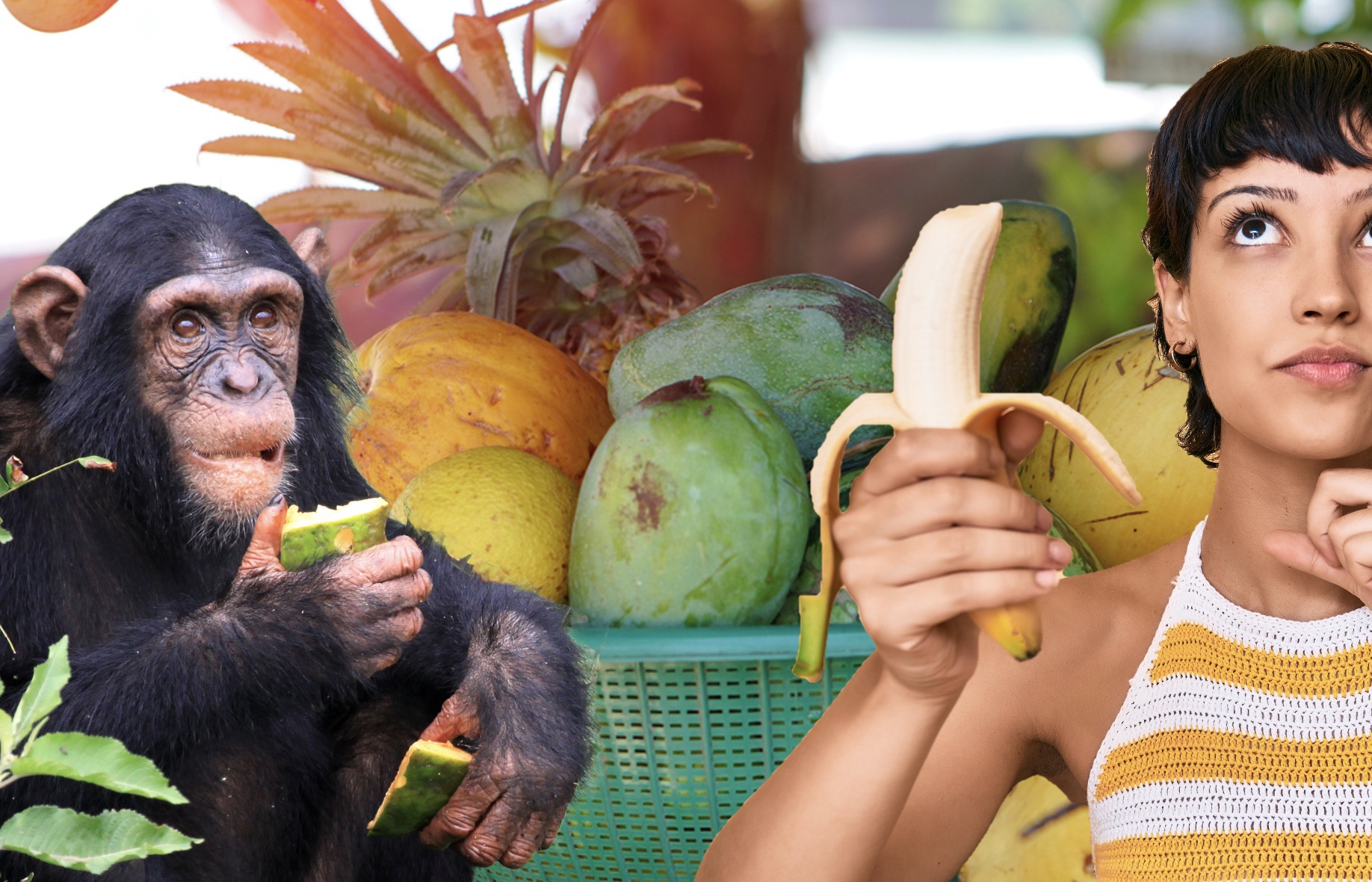
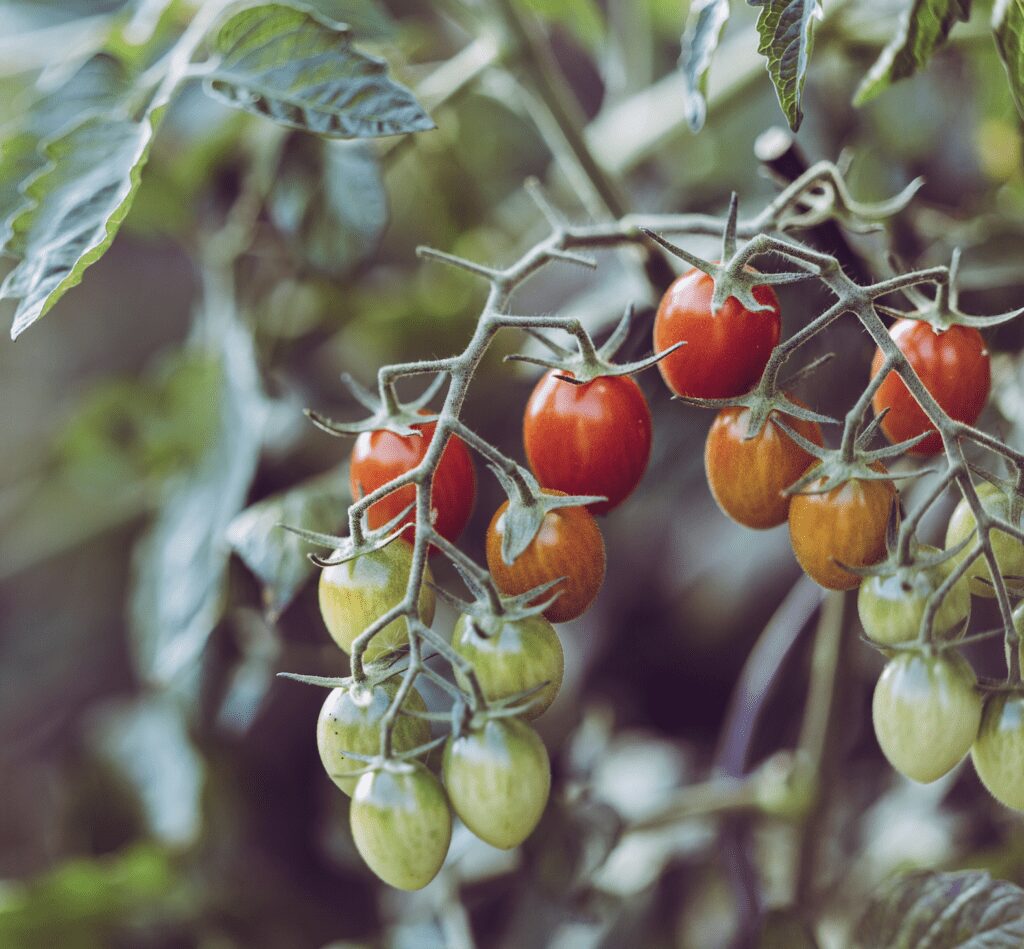

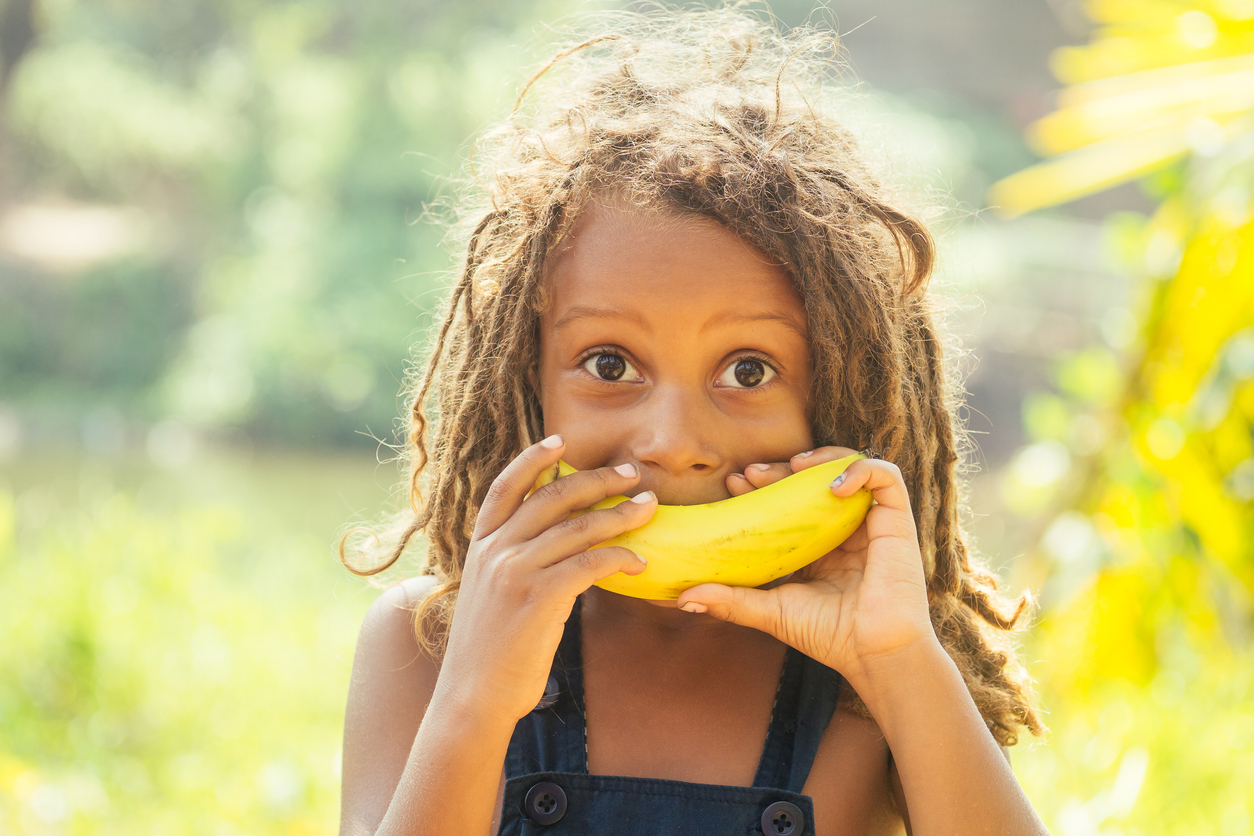
I love the emphasis on tropical fruits. I didn’t realize temperament fruits were not suitable. thank you. most people think all fruits are the same!!!!!
Yes, right? Not everyone is happy about hearing this, though. But most long-term fruit-eaters move to the tropics for this reason. It’s a major game changer to know this, and I think that not knowing about tropical fruits is what drives many people to believe that a fruit-based diet or raw diet does not work. It’s so simple when we know about our species: tropical frugivores need tropical fruits. I also feel sorry for the primates in zoos, which often get fed with temperate fruits, veggies and some crappy junk food pellets from veterinary companies. I think getting local, high-quality temperate fruits in colder climates is still super valuable as an addition to tropical fruits.
If you are interested in fruit and frugivore evolution, I have an article on this (not my best, but still, I think it’s important to really understand our diet).